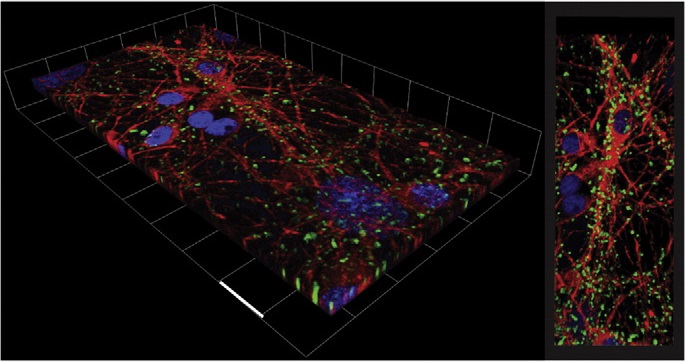Sculpting neurotransmission during synaptic development by 2D nanostructured interfaces
N. P. Pampaloni, D. Scaini, F. Perissinotto, S. Bosi, M. Prato, and L. Ballerini25.05.2017
Neurons are continuously exposed to signals generated by the environment, including physical cues at the nanoscale. This ability has been exploited to engineer interfaces with nanostructures with the aim of guiding nerve tissue re-growth. Conductive nanomaterials, such as carbon nanotubes, have been used to improve the growth of axons and to enhance the construction of synaptic connections between neurons. Enhancing cell-to-cell communication is crucial in neural circuits' settings, however the interactions between MWCNTs and the cellular surfaces are largely unexplored. More specific information about neuronal membrane stability when chronically interfaced to pristine nanomaterial-based growth substrates is lacking.
In this article, Prof. Ballerini et al. monitor the dynamics of glutamate receptor-mediated excitatory transmission in cultured hippocampal neurons. These were interfaced to MWCNTs, and studied by single cell electrophysiology and immunofluorescence microscopy. The main finding of the present report is that two-dimensional MWCNT interfaces do not alter the homeostasis of membrane lipids, in particular cholesterol, in neurons. In fact, neurons cultured interfaced to MWCNTs, display a similar membrane cholesterol distribution and, when we used a traditional tool to remove membrane cholesterol, MβCD, this treatment was as effective as in control cells. In this work it is confirmed the notion that MWCNT microenvironment provide cues instructing the construction of more synapses documented by the increase in PSCs frequency, in mPSCs and in VGLUT1-positive labeling.
In conclusion, MWCNTs when used in interfacing neurons can regulate synapse formation and function in a dynamic manner, tuning exquisite neurobiological mechanisms, such as neuronal maturation. This ability is however controlled and limited by the physiological maturation of the synaptic circuit. This functional integration of the MWCNTs within the newly formed neuronal network might represent an attractive property in designing interfaces for neuronal repair. Carbon nanotube-based biomaterials can critically contribute to the design of many prosthetic devices, with a particular impact in the development of bioelectronics components for novel neural interfaces.
More information:
This article has Open Access rights and can be downloaded here:
N. P. Pampaloni et al. Sculpting neurotransmission during synaptic development by 2D nanostructured interfaces. Nanomedicine 2017.
Related articles:
E. R. Aurand, Nanostructures to Engineer 3D Neural-Interfaces: Directing Axonal Navigation toward Successful Bridging of Spinal Segments. Adv. Funct. Mater. 2017.


